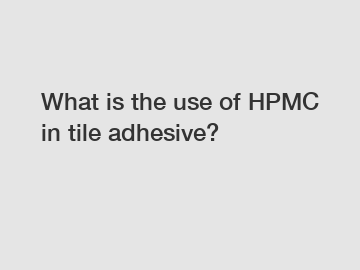What is the use of HPMC in tile adhesive?
What is the use of HPMC in tile adhesive?
Tile adhesive plays a crucial role in the installation of tiles, ensuring their proper adhesion to various surfaces. There are several additives used in tile adhesives to enhance their performance and properties. One such commonly used additive is Hydroxypropyl Methyl Cellulose (HPMC). HPMC is a versatile compound that offers numerous benefits, making it a valuable component in tile adhesive formulations. In this article, we will explore the various uses and advantages of HPMC in tile adhesive.
Improving Workability and Water Retention (H2).

HPMC is known for its ability to improve the workability of tile adhesive. It acts as a thickening agent, providing the required consistency for easy application and spreading. The addition of HPMC results in a smooth and creamy texture, allowing the adhesive to be easily troweled onto the substrate. Moreover, HPMC enhances the water retention capacity of tile adhesive, preventing it from drying out too quickly. This is particularly important in climates with high temperatures or low humidity, where fast drying can hinder proper adhesion.
Enhancing Bonding Strength (H2).
One key advantage of using HPMC in tile adhesive is its ability to enhance the bonding strength between the tiles and the substrate. HPMC forms a strong film on the surface, promoting adhesion and preventing the tiles from detaching over time. This is especially crucial in areas subjected to moisture, such as bathrooms and kitchens, where tile adhesion needs to withstand constant exposure to water. HPMC improves the overall durability and longevity of tile installations, ensuring they remain intact for years to come.
Reducing Shrinkage and Cracking (H2).
Shrinkage and cracking are common issues encountered in tile adhesives. However, the addition of HPMC can help minimize these problems. HPMC acts as a binder, reducing the shrinkage of tile adhesive during the drying process. It provides flexibility and elasticity to the adhesive, allowing it to accommodate slight movements without cracking. This is particularly significant in environments where temperature and humidity fluctuations can cause stress on the tiled surfaces.
Excellent Compatibility and Versatility (H2).
Another advantage of HPMC is its compatibility with different types of tile adhesive formulations. It can be used with various base materials, including cement, gypsum, and other polymers, making it highly versatile. HPMC does not negatively affect the properties of other components in the adhesive, ensuring a consistent and reliable formulation. Its compatibility extends to a wide range of substrates as well, including concrete, wood, and even metal surfaces.
Conclusion (H2).
In conclusion, Hydroxypropyl Methyl Cellulose (HPMC) is an essential additive in tile adhesive formulations, offering several benefits. Its role in improving workability and water retention helps achieve a smooth and easy application. By enhancing bonding strength and reducing shrinkage, HPMC ensures long-lasting and durable tile installations. Its compatibility with various base materials and substrates adds to its versatility. To experience the advantages of HPMC in your tile adhesive projects, contact us for high-quality products and expert guidance.
Keywords: contact us.
If you are looking for more details, kindly visit hpmc powder factory, gypsum retarders, hpmc manufacturer.
188
0
0


Comments
All Comments (0)